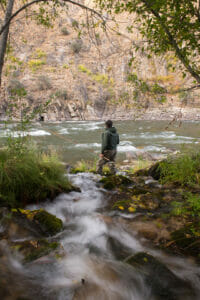Q.
Can we restore populations by improving habitat?
The data show conclusively that the Pacific Northwest’s climate is warming. The Snake River basin will experience hotter temperatures in the summer, which will make water conditions in the lower Snake River more problematic than they are at present.
High water temperatures in the Snake under current conditions can take a devastating toll. In 2015, 96 percent of Snake River sockeye returning to spawn succumbed to high water temperatures in the Columbia and Snake. This makes the need for restoring a free-flowing river more imperative.
Dams increase water temperature in the Snake to lethally high levels. The reservoirs warm during the summer months and create a block of slow-moving hot water that does not cool until fall air temperatures drop and remain cool. In contrast, though a free-flowing river will also occasionally warm to unhealthy levels during hot summer days, it will cool again at night when air temperature drops. This does not happen with the reservoirs because they retain their heat through the night.
Another key thermal difference between reservoirs and rivers is that in unstratified reservoirs like those in the lower Snake, water temperature is uniform so there are no cold-water refuges for fish to use. In contrast, dynamic rivers have different water temperatures in different locations.

For example, downstream of gravel bars where there is a lot of subterranean flow, temperatures can be substantially cooler than adjacent areas. These cooler areas provide refuges for migrating salmon and steelhead, which use them as “stepping stones” on their migratory journey. While it is true that instantaneous high water temperatures in a free-flowing river can exceed harmful levels, an argument often made by supporters of the lower Snake dams, in complex river habitats fish can find cool water when they need it and migrate safely./p>
In October 2019, a large group of scientists sent a letter to Pacific Northwest elected leaders informing them of the fact that restoring a free-flowing lower Snake River is the only known option for substantially cooling the lower Snake and enabling salmon and steelhead to migrate through it safely. They cited modeling by the Environmental Protection Agency that shows that removing the four lower Snake River dams would reduce Snake River water temperatures by 6.3 degrees F, on average, during the summer and early fall.
As discussed in the scientists’ letter, cold-water releases from Dworshak dam on the North Fork Clearwater are currently used to cool water temperatures in the lower Snake. The beneficial impact of those cold-water releases is limited to the area around the upper-most dam, Lower Granite, because the relatively small volume of the cold-water releases gets overwhelmed by the volume of hot water that accumulates in the reservoirs. If a free-flowing lower Snake River is restored, the cold water Dworshak releases will penetrate much further down the Snake and even help cool the mainstem Columbia.
Last but not least, most of the available habitat in the Snake River basin will remain productive for salmon and steelhead even with a warmer climate. The Snake Basin currently contains 20 percent of the stream habitat occupied by salmon and steelhead on the West Coast, but by 2080 it is forecast to contain 65 percent of the coldest, most climate-resilient stream habitats on the West Coast. In short, the Snake is our best hope for a large wild salmon and steelhead stronghold in the continental United States.

